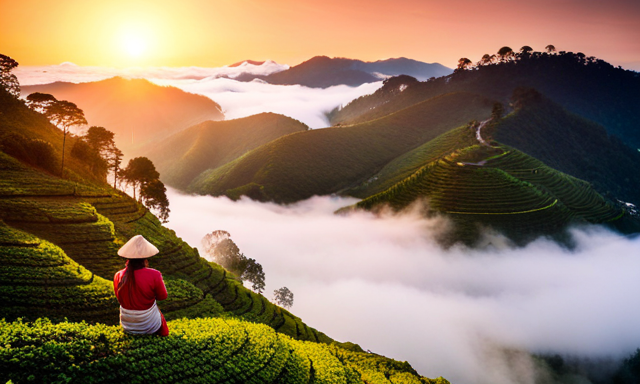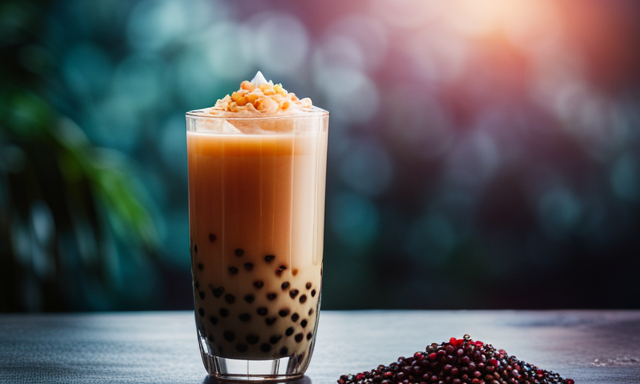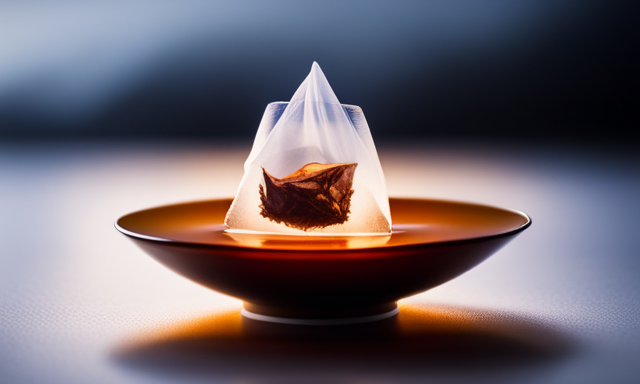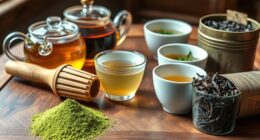As the old saying goes, ‘A journey of a thousand miles begins with a single step.’ And so it is with the world of tea. Today, I invite you to embark on a flavorful journey to discover the origins of oolong tea. This beloved beverage has captivated tea enthusiasts for centuries, and its rich history and unique characteristics make it a true gem in the tea world.
In this article, we will delve into the roots of oolong tea, tracing its origins back to ancient China. We will explore the meticulous cultivation process that brings out the tea’s distinct flavors and aromas.
From the rolling hills of Fujian to the mountainous regions of Taiwan, we will uncover the different varieties of oolong tea and the role that terroir plays in its production.
Moreover, we will delve into the health benefits of oolong tea, its significance in Taiwanese culture, and even share tips on how to brew the perfect cup.
So join me as we unravel the mystery of where oolong tea truly comes from and unlock the secrets of this remarkable beverage.
Key Takeaways
- Oolong tea is an integral part of Taiwanese culture and is commonly found in Taiwanese households and social gatherings.
- Brewing the perfect cup of oolong tea involves selecting high-quality loose leaf tea, heating water to the ideal temperature, steeping the leaves for the recommended duration, and enjoying the rich aroma and complex taste.
- Authentic oolong tea can be purchased from specialty tea shops, online tea retailers, and tea auctions, ensuring detailed descriptions, sourcing information, and customer reviews are considered for authenticity.
- Drinking oolong tea provides various benefits such as boosting metabolism, improving digestion, promoting heart health, providing antioxidants, and enhancing mental alertness.
The Origins of Oolong Tea
Oolong tea, known for its rich and complex flavors, originates from the misty mountains of China. Its origins can be traced back centuries, to the Fujian province, where the tea leaves are carefully handpicked and processed. The unique flavor profile of oolong tea is a result of the specific terroir and climate conditions in this region.
The history of oolong tea in China is fascinating. It was first discovered by tea farmers who noticed that the leaves, when partially oxidized, produced a unique taste and aroma. This led to the development of the intricate process of making oolong tea, which involves withering, rolling, and firing the leaves. Over time, oolong tea became highly prized and gained popularity not only in China but also around the world.
Now, let’s delve into the history of oolong tea in China, exploring its cultural significance and the traditions surrounding its consumption.
The History of Oolong Tea in China
Originating in China, the fascinating history of Oolong tea stretches back hundreds of years and captivates tea enthusiasts worldwide. The origins of Oolong tea can be traced back to the Fujian province in China during the Ming Dynasty. It was during this time that tea connoisseurs began experimenting with different processing techniques, resulting in the creation of Oolong tea. The unique combination of oxidation and withering gives Oolong tea its distinctive flavor and aroma. This intricate process requires great skill and expertise, as the tea leaves must be carefully monitored and processed at specific times. To truly appreciate the artistry behind Oolong tea, one must understand its rich history in China and the meticulous craftsmanship that goes into its production. Transitioning seamlessly into the subsequent section about the cultivation process of Oolong tea, we delve into the meticulous steps involved in bringing this exquisite tea to life.
The Cultivation Process of Oolong Tea
The cultivation of oolong tea begins with carefully selecting the finest tea leaves. This process is akin to a skilled artist handpicking the perfect colors for a masterpiece. Oolong tea requires specific cultivation techniques to achieve its unique flavor profiles.
First, the tea plants are grown in high altitude regions. The cool climate and misty mountain air in these areas contribute to the tea’s complex flavors.
Second, the leaves are plucked by hand. This ensures that only the young and tender leaves are selected, resulting in a higher quality tea.
Third, the leaves undergo a meticulous process of withering, rolling, and oxidizing. This process gives oolong tea its distinct aroma and taste.
Finally, the leaves are carefully dried to preserve their flavors. This step is crucial in maintaining the quality and integrity of the tea.
These cultivation techniques result in a wide range of oolong tea varieties, each with its own characteristics and nuances.
Transitioning into the subsequent section about different varieties of oolong tea, let’s explore the fascinating world of oolong tea flavors and how they vary from one type to another.
Different Varieties of Oolong Tea
Indulge in a sensory journey as you explore the diverse array of flavors found in the captivating world of oolong tea varieties. Oolong tea is known for its unique and complex flavors, ranging from floral and fruity to nutty and creamy.
Each variety of oolong tea offers a distinct taste profile that is influenced by factors such as the oxidation level, roasting technique, and the region it is grown in. The flavors can be further enhanced by the brewing techniques used, such as adjusting the water temperature and steeping time.
Whether you prefer a light and delicate oolong or a rich and robust one, there is a flavor to suit every palate.
Now, let’s delve into the role of terroir in oolong tea production, and discover how the environment plays a crucial role in shaping the tea’s characteristics.
The Role of Terroir in Oolong Tea Production
Get ready to explore the fascinating influence of terroir on the production of exquisite oolong tea varieties. The role of climate and the impact of soil are crucial factors that contribute to the unique flavors and characteristics of oolong tea.
Climate: Oolong tea thrives in regions with a mild and humid climate. The combination of warm temperatures and abundant rainfall provides the perfect conditions for tea cultivation. The specific climate of each region affects the growth rate of the tea leaves, which in turn influences the flavor profile of the final product.
Soil: The type of soil in which the tea plants are grown also plays a significant role in oolong tea production. Different soil compositions result in variations in mineral content, which can impart distinct flavors and aromas to the tea. For example, tea plants grown in rocky soil may produce oolong tea with a more robust and mineral-rich taste.
Understanding the importance of climate and soil in oolong tea production sets the stage for exploring the traditional methods of oolong tea processing.
Traditional Methods of Oolong Tea Processing
After understanding the role of terroir in producing high-quality oolong tea, it’s fascinating to delve into the traditional methods of processing this unique tea.
These methods have been passed down through generations and play a crucial role in creating the distinct flavors and aromas that oolong tea is known for.
In traditional tea ceremonies, oolong tea is prepared using specific steps to ensure the perfect infusion. The leaves are carefully selected, withered, and then partially oxidized before being rolled and dried. This intricate process requires skill and precision to bring out the desired qualities in the tea.
It’s interesting to note that oolong tea has gained popularity in Western culture as well, with its unique taste and health benefits attracting tea enthusiasts around the world.
As we transition into the next section about the health benefits of oolong tea, it’s important to understand the significance of its traditional production methods.
The Health Benefits of Oolong Tea
Regularly consuming oolong tea can offer a range of advantages for those who incorporate it into their daily routine. Here are three key health benefits of oolong tea:
-
Weight loss effects: Oolong tea has been shown to boost metabolism and increase fat oxidation, making it a great addition to a weight loss plan.
-
Anti-aging properties: This tea is rich in antioxidants, which help fight free radicals and reduce the signs of aging, such as wrinkles and fine lines.
-
Improved brain function: The caffeine and L-theanine content in oolong tea can enhance mental alertness and focus, promoting better cognitive performance.
With these remarkable health benefits, it’s no wonder that oolong tea holds a significant place in Taiwanese culture.
Oolong Tea in Taiwanese Culture
Embedded deep within the rich tapestry of Taiwanese culture lies a cherished tradition that has captivated the hearts and palates of generations: the fascinating role of oolong tea. Oolong tea is not just a beverage in Taiwan, it is an integral part of their cultural identity. Oolong tea ceremonies, with their precise rituals and graceful movements, are a common sight in Taiwanese households and social gatherings. It is believed that these ceremonies enhance the flavor and aroma of the tea, making it a truly sensory experience. Additionally, oolong tea holds a prominent place in Taiwanese cuisine, where it is used for both cooking and drinking. Its unique flavor profile lends itself well to dishes such as tea-infused braised meats and tea-smoked fish. As we delve deeper into the enchanting world of oolong tea, let’s explore how to brew the perfect cup and unlock its full potential.
How to Brew the Perfect Cup of Oolong Tea
Now that we’ve explored the significance of Oolong Tea in Taiwanese culture, let’s delve into the art of brewing the perfect cup of this exquisite beverage.
Mastering the brewing techniques not only ensures a delightful experience but also allows you to appreciate the full range of Oolong tea flavors.
To begin, select high-quality loose leaf Oolong tea, as it provides a more robust flavor profile.
Next, heat water to the ideal temperature, which varies depending on the specific type of Oolong tea.
Steep the leaves for the recommended duration, typically between 2 to 5 minutes, to extract the optimal balance of flavors.
Finally, savor the rich aroma and complex taste of your carefully brewed Oolong tea.
As we move forward to the next section on where to buy authentic Oolong tea, let’s explore the world of reputable tea vendors.
Where to Buy Authentic Oolong Tea
To find the most authentic Oolong tea, it’s important to explore reputable tea vendors. Here are three places where you can find high-quality Oolong tea:
-
Specialty Tea Shops: These shops often have a wide selection of Oolong teas sourced directly from tea farms in regions like Taiwan, China, and Japan. They can provide expert guidance on different varieties and brewing methods.
-
Online Tea Retailers: Many online retailers specialize in selling premium teas, including Oolong varieties. Look for websites that provide detailed descriptions, sourcing information, and customer reviews to ensure authenticity.
-
Tea Auctions: Occasionally, tea auctions offer rare and limited-edition Oolong teas. Participating in these auctions can be a great way to find unique and authentic Oolong teas, but it requires knowledge and experience.
Drinking Oolong tea has numerous benefits, including boosting metabolism, improving digestion, and promoting heart health. By sourcing your Oolong tea from reputable vendors, you can ensure that you’re getting the most authentic and beneficial tea experience.
Frequently Asked Questions
What are the different grades of oolong tea?
Differentiating oolong tea grades involves considering factors like leaf size, oxidation level, and production method. These factors greatly influence the quality and flavor of oolong tea, ensuring a wide range of options for tea enthusiasts.
How does oolong tea compare to other types of tea in terms of caffeine content?
In terms of caffeine content, oolong tea falls between green tea and black tea. On average, a cup of oolong tea contains about 37 mg of caffeine, while green tea has around 20 mg and black tea has approximately 47 mg.
Can oolong tea be aged, and if so, how does it change in flavor?
Yes, oolong tea can be aged, and the aging process results in a rich and complex flavor profile. As it matures over time, the tea develops deeper notes of wood, honey, and fruit, creating a truly exquisite taste experience.
Are there any specific regions famous for producing high-quality oolong tea?
There are several regions renowned for producing exceptional oolong tea. Their production techniques vary, resulting in unique flavors and aromas. Apart from its delicious taste, oolong tea also offers numerous health benefits.
What are some popular oolong tea blends or flavored varieties?
Some popular oolong tea blends include milk oolong, jasmine oolong, and ginseng oolong. Flavored oolong varieties include citrus oolong, peach oolong, and vanilla oolong. These blends and flavors add a unique twist to the traditional oolong tea experience.
Conclusion
In conclusion, Oolong tea is a captivating beverage with a rich history and origins rooted in China. Its cultivation process and the role of terroir play a significant role in its unique flavors and aromas.
With numerous health benefits and a prominent place in Taiwanese culture, Oolong tea is truly a treasure to be explored.
So, why wait? Brew yourself a cup of this exquisite tea and embark on a journey of taste and tradition that will leave you longing for more.
Cheers to the wonders of Oolong!










